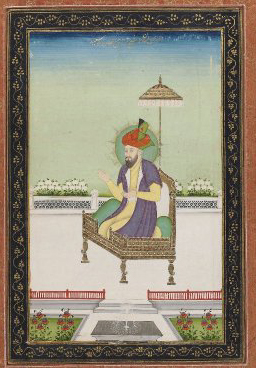
Babur, born Zahīr ud-Dīn Muhammad, was the founder of the Mughal Empire in the Indian subcontinent. He was a descendant of Timur and Genghis Khan through his father and mother respectively. He was also given the posthumous name of Firdaws Makani.

Mirza Nur-ud-Din Baig Muhammad Khan Salim, known by his imperial name Jahangir, was the fourth Mughal Emperor, who ruled from 1605 until his death in 1627. He was the third and only surviving son of Akbar and his chief empress, Mariam-uz-Zamani, born to them in the year 1569. He was named after the Indian Sufi saint, Salim Chishti.
Babar, also variously spelled as Baber, Babur, and Babor is a male given name of Pashto, and Persian origin, and a popular male given name in Pakistan. It is generally taken in reference to the Persian babr, meaning "tiger". There is a similar name in connotation to the Arabic male given form and generic name of the animal by the name "Nimr" which means "yellow-black stripped cat", i.e. "tiger".

The Bāburnāma is the memoirs of Ẓahīr-ud-Dīn Muhammad Bābur (1483–1530), founder of the Mughal Empire and a great-great-great-grandson of Timur. It is written in the Chagatai language, known to Babur as Türki ("Turkic"), the spoken language of the Andijan-Timurids. During the reign of emperor Akbar, the work was translated into Persian, the usual literary language of the Mughal court, by a Mughal courtier, Abdul Rahim Khan-i-Khanan, in AH 998.

The Mughal dynasty comprised the members of the imperial House of Babur (Persian: خاندانِ آلِ بابُر; Khāndān-e-Āl-e-Bābur), also known as the Gurkanis, who ruled the Mughal Empire from c. 1526 to 1857.

Tuzuk-e-Jahangiri or Tuzuk-i-Jahangiri or Jahangir-nama is the autobiography of Mughal Emperor Jahangir (1569–1627). Also referred to as Jahangirnama, the Tuzk-e-Jahangiri is written in Persian, and follows the tradition of his great-grandfather, Babur (1487–1530), who had written the Baburnama; though Jahangir went a step further and besides writing on the history of his reign, he included details such as his reflections on art, politics, and information about his family.

Kamran Mirza was the second son of Babur, the founder of the Mughal Empire and the first Mughal Emperor. Kamran Mirza was born in Kabul to Babur's wife Gulrukh Begum. He was half-brother to Babur's eldest son Humayun, who would go on and inherit the Mughal throne, but he was full-brother to Babur's third son, Askari. A divan written in Persian and Chagatai is attributed to him.

Gulbadan Begum was a Mughal princess and the daughter of Emperor Babur, the founder of the Mughal Empire.

The Mughal Empire was an early-modern empire that controlled much of South Asia between the 16th and 19th centuries. For some two hundred years, the empire stretched from the outer fringes of the Indus river basin in the west, northern Afghanistan in the northwest, and Kashmir in the north, to the highlands of present-day Assam and Bangladesh in the east, and the uplands of the Deccan Plateau in South India.

Umar Shaikh Mirza II was the ruler of the Fergana Valley. He was the fourth son of Abu Sa'id Mirza, the emperor of the Timurid Empire in what is now Kazakhstan, Uzbekistan, Afghanistan and eastern Iran.
Ruqaiya Sultan Begum was the first and chief wife of the third Mughal emperor, Akbar.

Salima Sultan Begum was the third wife and chief consort of the Mughal emperor Akbar, and the granddaughter of Babur.

Khas Mahal, meaning "The exquisite one of the palace", was one of the chief wives of the Mughal emperor Jahangir.
Bahar Banu Begum, meaning "The Blooming Lady", was a Mughal princess, the daughter of Mughal emperor Jahangir.
Bakht-un-Nissa Begum was a Mughal princess, the daughter of the Mughal emperor Humayun.
Masuma Sultan Begum was a Mughal princess and the daughter of the first Mughal emperor, Babur. She is frequently mentioned in the Humayun-nama by her sister, Gulbadan Begum, who calls her sister 'Elder sister Moon'.
Shakr-un-Nissa Begum, also Shakr al-Nisa Begum was a Mughal princess, the daughter of Emperor Akbar.
Luzzat-un-Nissa Begum was a Mughal princess, the youngest daughter of Emperor Jahangir and his Rathore wife, Jagat Gosain. She was also the full sister of Emperor Shah Jahan.
Shahzadi Khanam was a Mughal princess, the second surviving child and eldest daughter of Mughal Emperor Akbar.
After the mid-16th century, many Rajput rulers formed close ties with the Mughal emperors and served them in various capacities. It was because of the support of the Rajputs that Akbar was able to lay the foundation of the Mughal Empire in India. The Rajput nobles had their daughters married to the Mughal emperors and their princes for political purposes. For example, Akbar performed 40 marriages for himself and for his sons and grandsons, of which 17 were Rajput-Mughal alliances. The successors of the Mughal emperor Akbar, the mothers of his son Jahangir and grandson Shah Jahan were Rajputs. The Sisodia Rajput family of Mewar made it an honor not to enter into matrimonial relations with the Mughals, and thus stood in contrast to all other Rajput clans. After this time, the marital relations between the Rajputs and the Mughals declined somewhat. Akbar's relations with the Rajputs began when he returned in 1561 from a visit by the Chisti Sufi Shaikh of Sikri, west of Agra. Then many Rajput princesses married Akbar.










